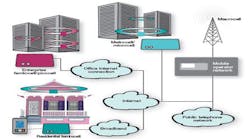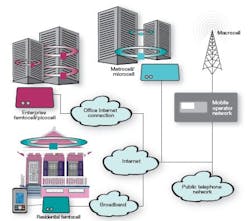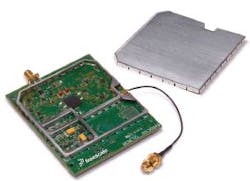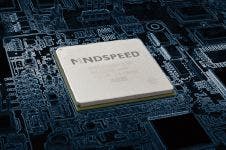The same story is being told in many places: Now that high-bandwidth applications have been adopted en masse by cellular-phone and tablet users, wireless system operators are running out of capacity. As they face this shortage, consumers are rapidly growing in number and adopting more data-intensive applications. As a result, there has been much debate and hand-wringing over how sufficient capacity can be provided. The answer is a new approach to cellular infrastructure—the heterogeneous network (HetNet). Rather than just beef up the existing cell sites and add new ones where possible, new network rollouts will supplement large base-station coverage with smaller cells. Be they residential, enterprise, or metro-focused, these smaller cells will bring the quality of service of large cells inside buildings while filling network "holes," where high speeds and high bandwidth would not otherwise have been available (Fig. 1).
1. This graphic, courtesy of the Small Cell Forum, shows how small cells will extend the connectivity of various networks while increasing available capacity.
Smaller cells have been discussed as a potential solution for years. Now, their time has truly come. Rupert Baines, Vice President of Marketing at Mindspeed (www.mindspeed.com), states, "First operators are placing production orders now. We announced SK Telecom and KT (both in Korea) are placing production orders for Long-Term-Evolution (LTE) small cells for deployment this year. AT&T, Vodafone, and Verizon Wireless have all said they will deploy LTE small cells starting next year."
Sprint is now commanding one of the largest rollouts. According to Informa Telecoms & Media (www.informatm.com), the carrier has announced the rapid acceleration of its femtocell deployment to a total of 600,000 units—up from 250,000 units in 2011. It also is increasing its metro-area coverage by deploying Alcatel-Lucent’s (www.alcatel-lucent.com) lightRadio metro cells. These mini-base-stations can be deployed indoors or outdoors—for example, on lamp posts or street signs or inside shopping malls or stadiums.
Such efforts underscore Sprint’s current work on an all-new HetNet, which it has named Network Vision. This network will include the deployment of an improved third-generation (3G) network as well as fourth-generation (4G) LTE. Small-cell technology complements the Network Vision plan by providing lower-cost infrastructure to expand coverage and capacity in targeted high-usage areas.
Sprint’s efforts provide good examples of both a HetNet and the trends in small-cell adoption. According to the most recent quarterly small-cell market status report from Informa, operator interest in public-access small cells is growing while the femtocell (residential-small-cell) market is making progress. Small cells will outnumber all macrocells globally during the fourth quarter of this year. Femtocells constitute over 80% of the 4.6 million small cells currently deployed globally across the 41 operator deployments (compared to 5.6 million conventional macrocells). By the close of 2012, Informa predicts, there will be 6.4 million small cells. Of those, 86% will be femtocells. Thus, femtocells alone will outnumber all macrocells in the first quarter of 2013.
The mission of small cells is tri-fold: to add capacity, extend coverage, and offload traffic from larger cells. A recent study by the Small Cell Forum (formerly the Femto Forum; www.smallcellforum.org) found that even a relatively conservative small-cell deployment—with four devices per macrocell—would increase typical data rates by over 300% and offload 56% of data. However, Informa points out that public-access small cells also could positively impact rural and developing markets. Recently, African operator RascomStar-QAF announced that it is running trials using satellite backhaul in the Congo. Ongoing trials also are being conducted by Vodafone UK and a rural deployment by SoftBank in Japan.
Small Cells, Big Challenges
Like all things wireless, small cells have had to prove their performance in the face of issues like interference and security concerns. With real-world deployment just beginning in large numbers, Baines foresees two issues creating the most challenges. The first is to make deployment and provisioning inexpensive and easy. The second challenge is how to effectively accomplish backhaul. Baines poses the question: "Do you use fiber to the lamp-post? Wireless? WiFi? E-band?" Some of these approaches complicate deployment and add to the expense of the network.
When the goal is to reliably backhaul potentially thousands of small-cell nodes, most traditional approaches become prohibitively expensive. As a result, many novel approaches to backhaul are currently being tried, tested, and implemented. Take Telefonica UK, which effectively eliminates the backhaul problem by meshing traffic over 5-GHz WiFi mesh links between nodes using Ruckus Wireless’ (www.ruckuswireless.com) Smart Mesh technology.
Smart Mesh’s success has shown that it is possible to deliver reliable backhaul for licensed cellular and unlicensed WiFi traffic in both line-of-sight and non-line-of-sight environments. Smart Mesh uses advanced self-organizing-network (SON) principles with Ruckus-patented adaptive antenna arrays (BeamFlex) and predictive channel-management techniques (ChannelFly). Together, these technologies create resilient, fast, WiFi mesh-backbone links between nodes. Those links automatically adapt to changes in environmental conditions.
The result is yet another form of a HetNet. Ruckus’ SmartCell 8800 modular multi-radio system integrates patented adaptive-antenna-array technology, which supports multiple licensed and unlicensed radio technologies. Among these technologies are high-speed, dual-band IEEE 802.11n WiFi, small-cell 3G/4G radios, and 5-GHz wireless backhaul. Operators can co-locate and combine LTE small cells with WiFi access points, sharing site-lease agreements and backhaul.
These new network models translate into opportunities for many manufacturers. For example, the base-station transceiver market, which has been experiencing a rather significant slowdown for the past year and a half, is expected to stabilize with the rollout of LTE. According to a report by Mobile Experts (www.mobile-experts.net), "Semiconductors for Macro Transceivers and RRH," the number of base-station transceivers will grow to more than 17 million per year by 2017. Increasing bandwidth requirements, multiple-input multiple-output (MIMO) architectures, and carrier aggregation will drive growth in key semiconductor components. The devices that are expected to benefit from this growth include analog-to-digital converters (ADCs), digital-to-analog converters (DACs), and system-on-a-chip (SoC) multifunction components.
Paul Hart, RF Systems Engineering Manager at Freescale (www.freescale.com), notes that integrated solutions in particular are proving popular. "Cellular base stations require many discrete components that, when sought out separately, can be a cumbersome and expensive task for manufacturers," he explains. "Because of all the parts associated with building out a small-cell network, OEMS are looking for solutions that combine all components—from an RF radio board to the IC to the SoC."
To make the jump from 3G to next-generation 4G and LTE-A networks, Hart states that manufacturers also are asking for comprehensive, scalable solutions that support a range of air interfaces. "If the support for one standard is proven and the ability to scale up and over to next-generation standards is there, the development time will be reduced and the design flexibility will be improved to ensure a quicker response to network demands," he explains.
To provide such flexibility and integration for small-office/home-office (SOHO) applications, for example, Freescale offers a baseband-to-antenna reference design for multi-standard small-cell base stations (Fig. 2). This printed-circuit-board (PCB) solution is partially powered by two gallium-arsenide (GaAs) monolithic microwave integrated circuits (MMICs)—the MMZ25332B and MMZ09312B amplifiers. Two of Freescale’s low-noise amplifiers (LNAs)—the MML09211H and MML20211H—are included on the PCB as well. These devices are specifically designed for the receiver sensitivity requirements of femtocells. The baseband-to-antenna reference design combines the QorIQ Qonverge BSC9131 base-station SoC, which supports a range of air interfaces, with Freescale RF radio boards. The multi-protocol solution scales a range of cellular bands to ease the transition from 3G to 4G LTE.
2. By combining RF products with an SoC, this reference design offers an integrated solution for small-cell base-station markets as they transition from 3G to 4G.
Despite the success of such novel approaches, the interior of buildings still poses a tricky challenge for wireless service providers. Traditionally, distributed-antenna-systems (DASs) improved cellular coverage by ensuring that radio signals reached all areas—although not always at increased data rates. In contrast, small cells typically serve an area around a base station (perhaps 100 m in a city and as much as 2 km in a rural area), which is suitable for providing sufficient capacity in busy train stations or congested commercial intersections. Yet they are less suited to the complex structure of corridors in a large building, where coverage shadows or black spots are common.
In hopes of solving this coverage dilemma, Mindspeed has included support for smart-DAS technology in its SoCs for small-cell products—specifically, the Transcede PC333 and PC3032 SoCs for HSPA+ products (Fig. 3). As a result, those SoCs can now handle the delay characteristics of the long coaxial networks and specific antenna technology associated with DAS. DAS also will be supported on the firm’s dual-mode (HSPA+ and LTE) T2200 and T3300.
3. To provide both capacity and coverage in challenging indoor environments, DAS support is being integrated into some of this product family’s small-cell SoCs.
Beyond range and capacity needs, wireless networks must provide a seamless user experience as users move among these different coverage points. Thus, the synchronization of the small cells with macro base stations is critical (Fig. 4). Among the most recent efforts from Symmetricom (www.symmetricom.com) are embedded timing and synchronization solutions for both enterprise and residential small cells.
4. Here, synchronization requirements are shown according to small-cell type. (Graphic courtesy of Symmetricom)
The SCr (residential) and SCe (enterprise) SoftClocks support multiple timing protocols including IEEE 1588 (PTP), network time protocol (NTP), and softGPS. By leveraging existing hardware resources, this software synchronization solution supports a variety of backhaul types and associated requirements. Small-cell designers can therefore execute a single base design with options to integrate one or more synchronization protocols for deployment in varied network topologies.
What’s Next For Small Cells
Small cells suffered a bit from the wireless "hype" cycle in that they were discussed long before they were deployed. In this case, however, the delay seemed to allow firms to resolve a lot of issues and provide better groundwork for 4G transitions. Like the few examples cited here, this vast market is benefiting from the fact that reliable and proven solutions are available—and the numbers prove it.
Yet the work is far from done. According to Scott Aylor, Director and GM for Freescale’s Wireless Access Division, "The next-generation LTE and LTE-A network will require that cellular base stations—from small cells to the macro level—offer significant advancements in computational capacity for increasing network demands. Additionally, there will be a need for more intelligent connectivity and routing via next-generation communications processors, which work with an integrative software ecosystem to enable optimized throughput and compatibility across the heterogeneous network."
Mindspeed’s Baines is seeing hints of disruptive changes on the horizon. "In many areas of technology," he explains, "we see markets explode as they shift from in-house developments on generic devices to SoCs with reference designs and complete solutions. We saw it in DSL, WiFi, and even in computers—when it stopped being mainframes running custom software on custom silicon to PCs and Wintel.
"I see a similar transition here," Baines continues. "Macrocells with custom software developed in house by an OEM are converting to small cells developed using SoC and software—a reference design from a chip vendor that delivers a complete solution. Once again, this will be disruptive change…I met one operator who is wondering very seriously, ‘If I have small cells, why do I need macro cells?’—just like a business owner might say, ‘If I have PCs, why do I need a mainframe?’" Eventually, big base stations could become a thing of the past—replaced by their smaller, more numerous descendants.




